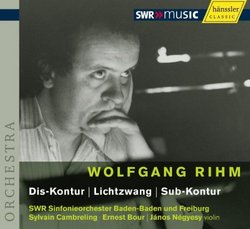Three powerful 1970s orchestral works
R. Hutchinson | a world ruled by fossil fuels and fossil minds | 06/07/2009
(5 out of 5 stars)
"The 22-year old Wolfgang Rihm stunned Germany's avant music world when his 40-minute work MORPHONIE was performed at the Donaueschinger Musiktage, the long-running avant music festival, in 1974. A work of strong expressionism written in 1972, it launched Rihm's credo -- "Music must be full of emotion, and the emotion full of complexity." A recording from the same year by Ernest Bour and the SWR can be found on Hanssler.
These three orchestral works, all recorded by the SWR, all followed shortly thereafter, from 1974 to 1976. DIS-KONTUR (22'44 -- 1974) and SUB-KONTUR (26'42 -- 1974/75) are both examples of polystylism as found in Berio's "Sinfonia" and Schnittke's works of the Seventies. Both pieces are dedicated to Rihm's teachers, DIS-KONTUR to Klaus Huber, and SUB-KONTUR to Karlheinz Stockhausen.
DIS-KONTUR, which opens with pounding percussion, is described by Rihm as a "latent march." As the title implies, it is discontinuous, periodically broken up and starting anew. There is one humorous passage that suggests the crazed Allegretto of Ives's Fourth Symphony with a marching band in the distance. According to Rihm, "...[a]n available type of musical idiom is uncovered and nearly exorcised. In "Dis-Kontur," it was "the march," the act of determinedly going forward, which gradually frees itself from a percussive web and is then atomized in the explosion of its own liberation." The current recording is from 2002, led by Sylvain Cambreling.
"In SUB-KONTUR," says Rihm, "it is the type of the melodic adagio, a cipher rising from below throught the constantly present attacks of a state of musical rawness..." "...[t]he adagio type becomes more and more recognizable ... up to the point where the adagio formulates itself in all clarity, where it achieves a breakthrough." Indeed, it sounds like Mahler periodically interrupts Rihm, similar to the way that Berio uses Mahler's Symphony No. 2 in "Sinfonia." This juxtoposition can be found as well in Rihm's String Quartet No. 3, of course, which is from the same period. Both DIS-KONTUR and SUB-KONTUR have also been recorded live at the Musica Viva Festival by the Bavarian Radio Symphony Orchestra and released on Col Legno.
The third piece here, programmed second in between the other two, is a violin concerto called LICHTZWANG (18'06 -- 1975/76), or Light Constraint, which is for "Paul Celan in memoriam." The musical language is similar to the other works of this period. The violin is played by Janos Negyesy, while the SWR is led by Ernest Bour in 1977. According to Rihm, the solo voice repeatedly reaches for the heights, "synonymous with radiance," and runs into interference from the orchestra. This is a fine concerto, an excellent complement to those already found in Hanssler's Rihm-Edition, Volume One. (Negyesy can also be heard heard playing an excellent concerto by Roger Reynolds -- see my review.)
This disc is Volume Two in Hanssler's Rihm-Edition. So far it looks like the schedule is one release a year. Volume One collected four concertos, and Volume Three is three orchestral and two choral works.
So far I could not be more impressed with the programming and packaging of the Rihm-Edition discs. For instance, this Volume Two has liner notes by the composer, essays written at the time of completion of each composition. And I love the cover photo of the young Rihm concentrating in the SWR studio! This set splendidly expands our appreciation of the young Rihm, right out of the gate with powerful works for orchestra. Hanssler is making available historic recordings of the SWR (SWR Sinfonieorchester Baden-Baden und Freiburg and SWR Stuttgart) for the series, and I look forward to more releases!"


 Track Listings (3) - Disc #1
Track Listings (3) - Disc #1